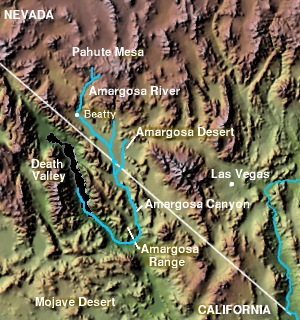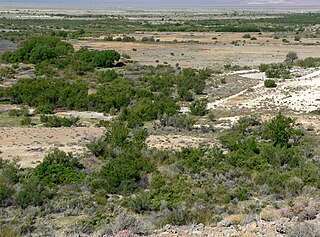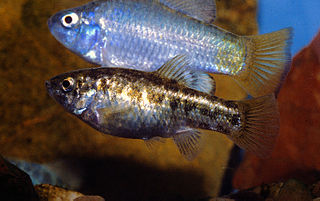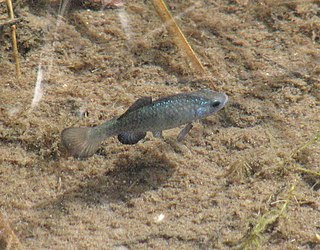
The Death Valley pupfish, also known as Salt Creek pupfish, is a small species of fish in the family Cyprinodontidae found only in Death Valley National Park, California, United States. There are two recognized subspecies: C. s. salinus and C. s. milleri. The Death Valley pupfish is endemic to two small, isolated locations and currently classified as endangered.

The Amargosa River is an intermittent waterway, 185 miles (298 km) long, in southern Nevada and eastern California in the United States. It drains a high desert region, the Amargosa Valley in the Amargosa Desert northwest of Las Vegas, into the Mojave Desert, and finally into Death Valley where it disappears into the ground aquifer. Except for a small portion of its route in the Amargosa Canyon in California and a small portion at Beatty, Nevada, the river flows above ground only after a rare rainstorm washes the region. A 26-mile (42 km) stretch of the river between Shoshone and Dumont Dunes is protected as a National Wild and Scenic River. At the south end of Tecopa Valley the Amargosa River Natural Area protects the habitat.

The Amargosa Valley is the valley through which the Amargosa River flows south, in Nye County, southwestern Nevada and Inyo County in the state of California. The south end is alternately called the "Amargosa River Valley'" or the "Tecopa Valley." Its northernmost point is around Beatty, Nevada and southernmost is Tecopa, California, where the Amargosa River enters into the Amargosa Canyon.

The Tecopa pupfish is an extinct subspecies of the Amargosa pupfish. The small, heat-tolerant pupfish was endemic to the outflows of a pair of hot springs in the Mojave Desert of Inyo County, California. Habitat modifications, the introduction of non-native species and hybridization with the related Amargosa River pupfish led to its extinction around 1979.
The Shoshone pupfish is a subspecies of Cyprinodon nevadensis from California in the United States. It is characterized by large scales and a "slab-sided," narrow, slender body, with the arch of the ventral contour much less pronounced than the dorsal. It also has fewer pelvic fin rays and scales than the other subspecies of C. nevadensis.

The Ash Meadows National Wildlife Refuge is a protected wildlife refuge located in the Amargosa Valley of southern Nye County, in southwestern Nevada. It is directly east of Death Valley National Park, and is 90 mi (140 km) west-northwest of Las Vegas.

The Devils Hole pupfish is a critically endangered species of the family Cyprinodontidae (pupfishes) found only in Devils Hole, a water-filled cavern in the US state of Nevada. It was first described as a species in 1930 and is most closely related to C. nevadensis and the Death Valley pupfish. The age of the species is unknown, with differing analyses offering ranges between one thousand and sixty thousand years. It is a small fish, with maximum lengths of up to 30 mm (1.2 in). Individuals vary in coloration based on age and sex: males are bright metallic blue while females and juveniles are more yellow. A defining trait of this species is its lack of pelvic fins. The pupfish consumes nearly every available food resource at Devils Hole, including beetles, snails, algae, and freshwater crustaceans, with diet varying throughout the year. It is preyed on by the predaceous diving beetle species Neoclypeodytes cinctellus, which was first observed in Devils Hole in 1999 or 2000. Reproduction occurs year-round, with spikes in the spring and fall. Females produce few eggs and the survivorship from egg to adult is low. Individuals live 10–14 months.

The Amargosa Desert is located in Nye County in western Nevada, United States, along the California–Nevada border, comprising the northeastern portion of the geographic Amargosa Valley, north of the Ash Meadows National Wildlife Refuge.

Devils Hole is a geologic formation located in a detached unit of Death Valley National Park and surrounded by the Ash Meadows National Wildlife Refuge, in Nye County, Nevada, in the Southwestern United States.

Cyprinodon is a genus of pupfishes found in waters that range from fresh to hypersaline. The genus is primarily found in Mexico, the Caribbean Islands and southern United States, but C. variegatus occurs as far north as Massachusetts and along the entire Gulf of Mexico coastline, and C. dearborni and C. variegatus are found in northern South America. Many species have tiny ranges and are highly threatened, in some cases already extinct. Cyprinodon are small; the largest reaches 10 cm (3.9 in) in length and most other species only reach about half that size.
Robert Rush Miller was an important figure in American ichthyology and conservation from 1940 to the 1990s.
The Leon Springs pupfish is a species of fish in the family Cyprinodontidae. It is endemic to Pecos County, Texas in the United States. It is a federally listed endangered species.

The Owens pupfish is a rare species of fish in the family Cyprinodontidae, the pupfish. It is endemic to California in the United States, where it is limited to the Owens Valley. It is a federally listed endangered species of the United States. This pupfish is up to 5 centimetres long, the largest males sometimes longer. The male is blue-gray, turning bright blue during spawning. The female is greenish brown with a silvery or whitish belly.

The desert pupfish is a rare species of bony fish in the family Cyprinodontidae. It is a small fish, typically less than 7.62 cm (3 in) in length. Males are generally larger than females, and have bright-blue coloration, while females and juveniles are silvery or tan. A notable attribute of the desert pupfish is their ability to survive in environments of extreme salinity, pH, and temperature, and low oxygen content. The desert pupfish mates in a characteristic fashion, wherein compatible males and females will come in contact and collectively jerk in an s-shape. Each jerk typically produces a single egg that is fertilized by the male and deposited in his territory. Breeding behavior includes aggressive arena-breeding and more docile consort-pair breeding.

The Sonoyta pupfish or Quitobaquito pupfish is an endangered species of pupfish from Sonora in Mexico and Arizona in the United States.

Nitrophila mohavensis is a rare species of flowering plant in the family Amaranthaceae known by the common name Amargosa niterwort. It is endemic to Nye County in southwestern Nevada and Inyo County, in eastern California.
The Death Valley freshwater ecoregion is a freshwater ecoregion in the western United States. It consists of endorheic rivers, lakes, and springs in the drainages of the Owens, Amargosa, and Mojave Rivers, in central-eastern California and southwestern Nevada.
The Amargosa springsnail is a snail in the family Hydrobiidae. It is endemic to the Amargosa River drainage of the southwestern United States. The small snail is known to occur in several near-brackish springs, including the type locality of Saratoga Springs in Death Valley.
The Saratoga Springs pupfish is a subspecies of the Amargosa pupfish of the family Cyprinodontidae. The native population is endemic to Saratoga Springs, a small wetland in Death Valley National Park in the United States.

The Amargosa River pupfish is a member of a pupfish species complex which inhabits the watershed of ancient Lake Manly. Currently, the species inhabits two disjunct perennial reaches of the lower Amargosa River. The upstream portion is near Tecopa and passes through the Amargosa Canyon. The lower portion is northwest of Saratoga Springs, just at the head of Death Valley, where the Amargosa River turns north to enter the valley.

















